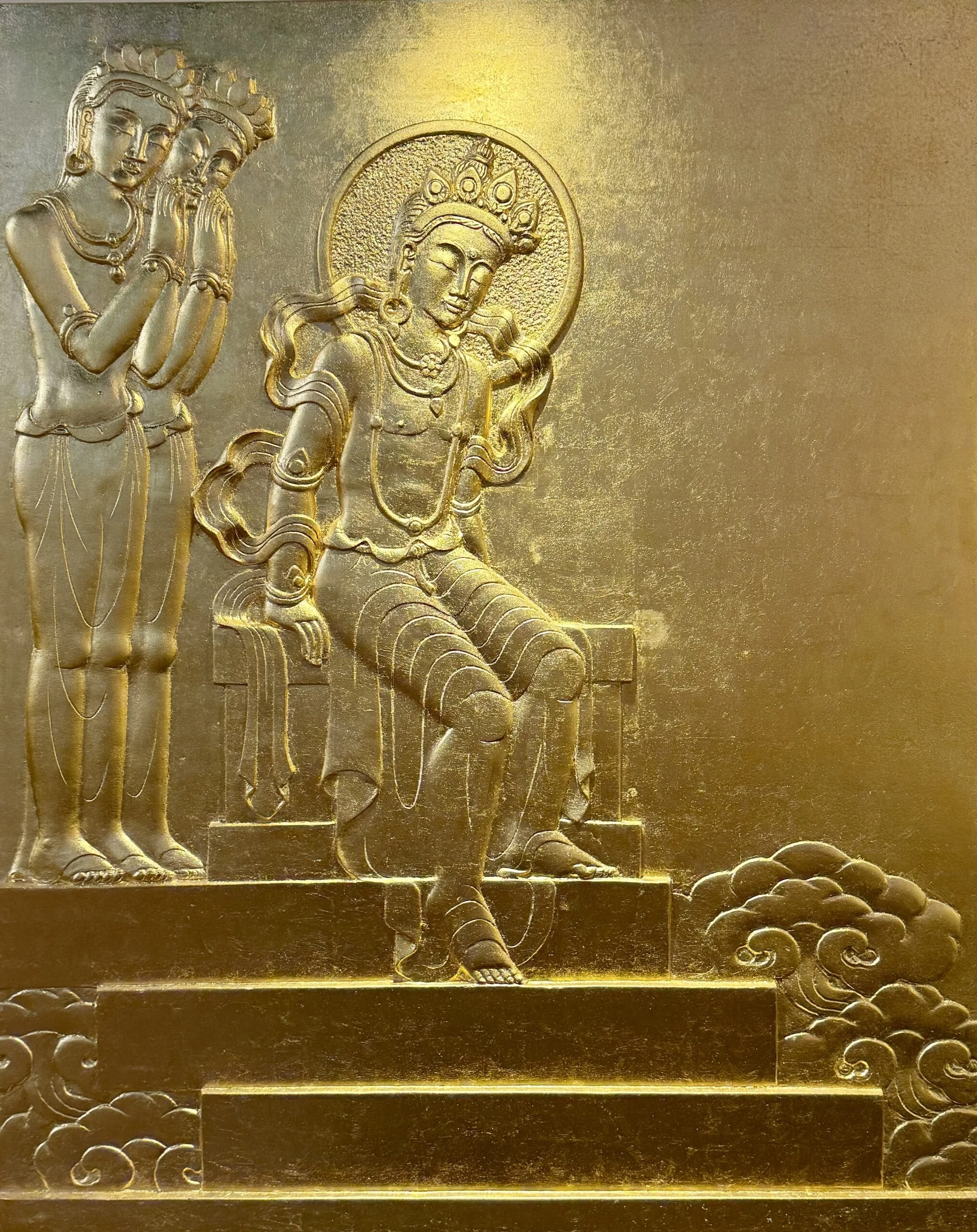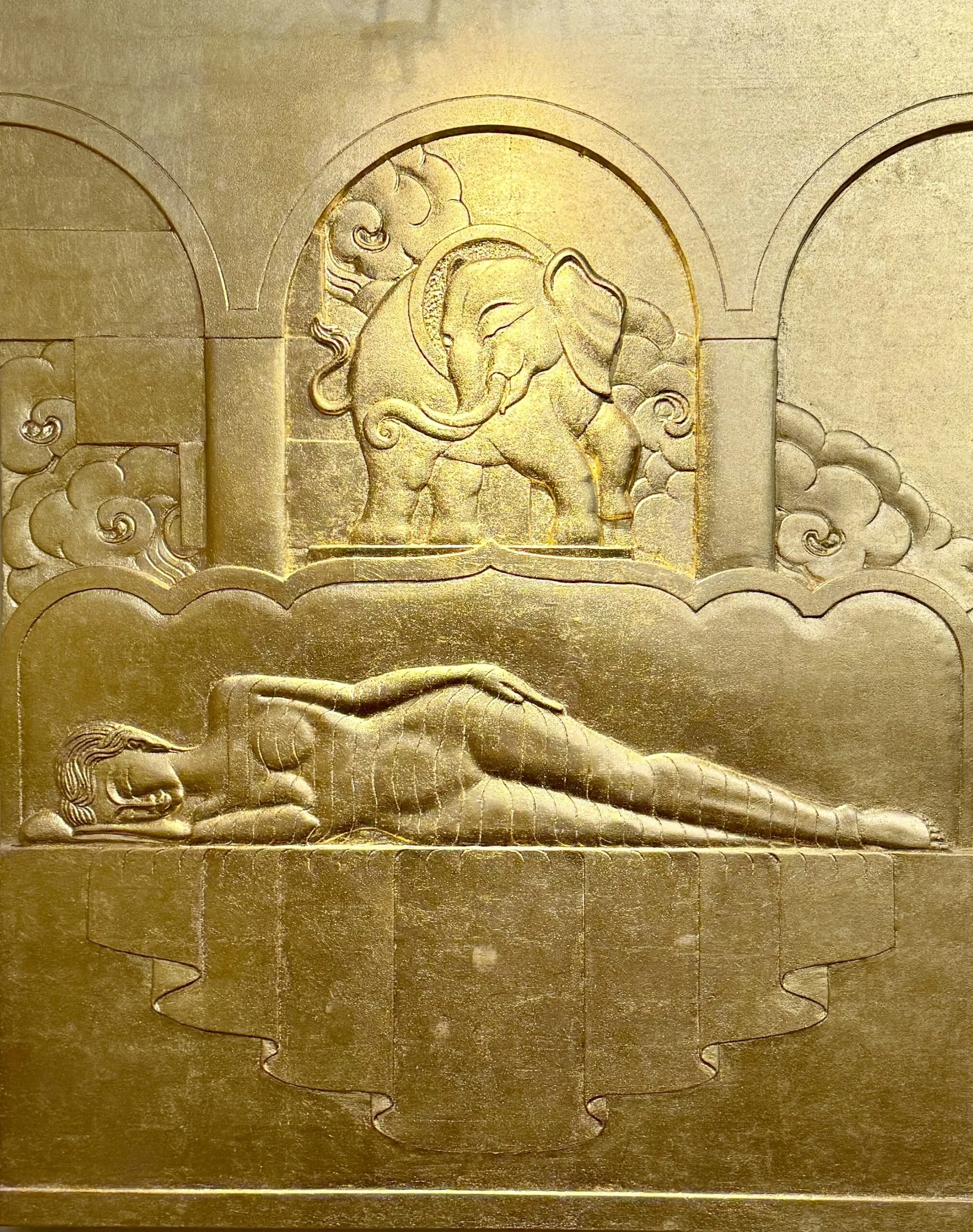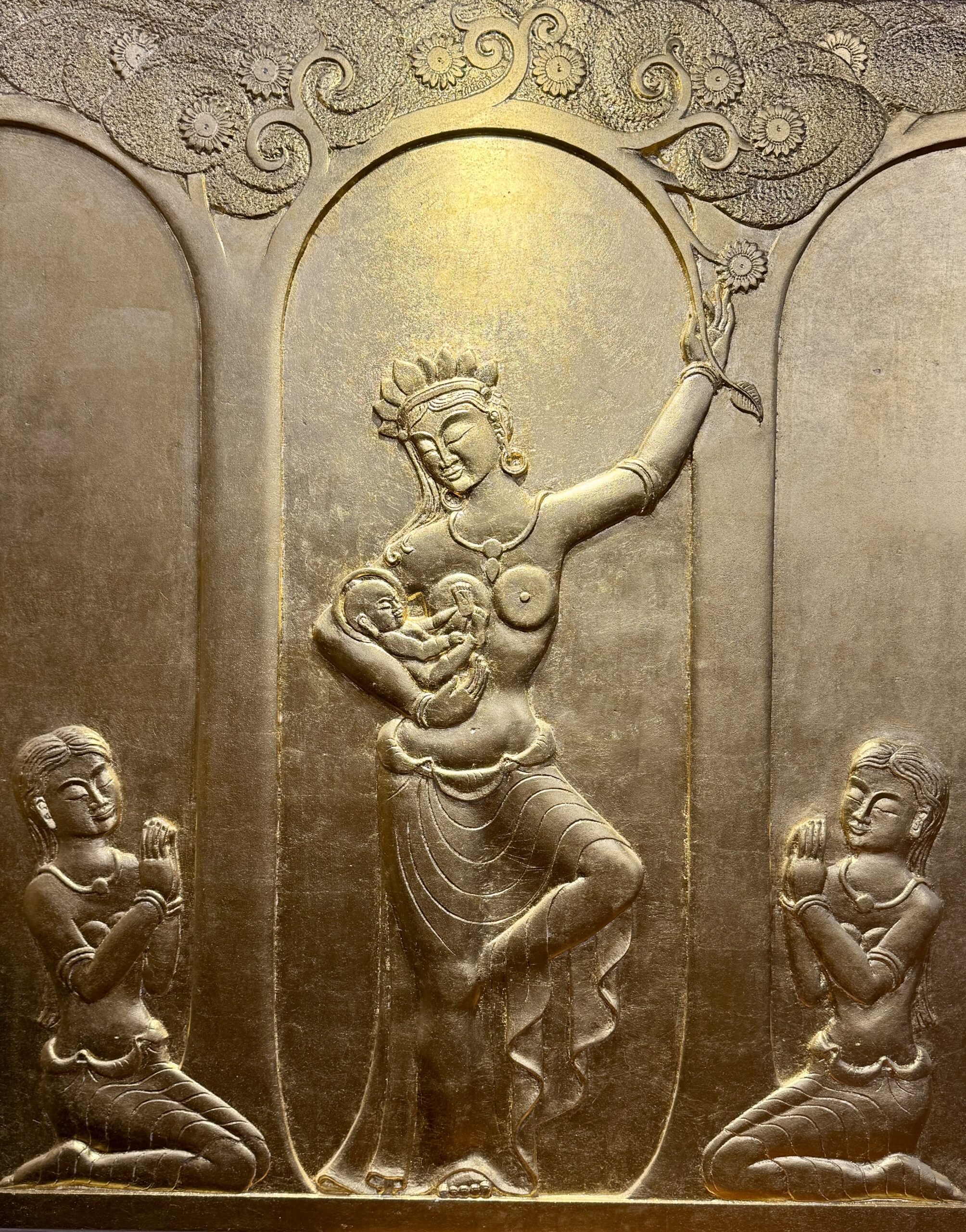This essay was originally written for the Jamyang Buddhist Centre in London
If we had to choose a historical figure that left the greatest imprint on the landscape of Indo-Tibetan Buddhism—next to the historical Buddha himself—very few individuals would be able to compete with the towering greatness of Padmasambhava. This teacher, whose name translates to “Lotus Born” and whom Tibetans affectionately call “Guru Rinpoche” (Precious Guru), is, in actuality, more than a mere individual: he could more appropriately be described as a field, since both his activities and his teachings preserved to this day form a vast and dynamic network that still affects the world in small and large ways. (Beyond that, we could say that each one of us is a field of interdependent phenomena—except Guru Rinpoche was able to turn his phenomena into expressions of enlightenment).
Padmasambhava’s role in the history of Tibetan Buddhism is hard to overestimate. Invited by the king Trison Deutsen and Nālandā scholar Shantarakshita to Tibet as a tantric adept, he famously subjugated the local obstructing forces, trained a bevy of highly qualified tantric practitioners, and transmitted numerous practice cycles that were both preserved orally and hidden for future generations as the so-called “treasure teachings” (terma).
What happened before this period of intense activity (roughly corresponding to the 8th-9th centuries) is a bit of a mystery: it is safe to assume that he spent many years receiving, applying, and realising the teachings of sūtra and tantra, but the specifics of how that occurred are described somewhat differently in his different hagiographies. As a figure associated with the highest degrees of realisation, Padmasambhava is very elusive when it comes to biographic specifics—and extremely vivid when it comes to his teaching legacy and his place in the spiritual life of Buddhist practitioners across the Himalayan region, where he is still invoked daily for help in matters ranging from the safety of cattle to realising enlightenment. One could perhaps say that the footprints of Guru Rinpoche are too numerous for him to fit into a neat, simple, coherent biography; and yet chasing him across time, space, and the Dharma itself is a fascinating journey worth undertaking, at least as a mental (or virtual) experiment.
Guru Rinpoche in time
Guru Rinpoche’s birth is in itself a big mystery. His very name, Padmasambhava, implies that he was miraculously born from a lotus, and some hagiographies indeed describe just that—an emanation of Buddha Amitābha appearing on lake Dhanakosha as a little boy who soon gets discovered and adopted by the local king. Other descriptions, however, talk of Padmasambhava’s physical birth from flesh and blood parents, or describe him miraculously appearing in a different part of India. To summarise it all, in one of Guru Rinpoche’s own treasure teachings (rediscovered by Chokgyur Dechen Lingpa in the XIX century) he states:
Perceived by some, I magically appeared in Uḍḍiyāna,
Upon a lotus flower on the waters of Dhanakośa.
Perceived by others, I was the son of Uḍḍiyāna’s king.
Perceived by still others, I descended as a thunderbolt
Onto the peak of Mount Meteoric Iron.
Guru Rinpoche proceeds to say that this happened 24 years after the passing of Buddha Śākyamuni. As a young man, he also reportedly studied the sutric discourses with Ānanda, the Buddha’s primary attendant. This immediately raises a question: doesn’t that mean that Padmasambhava lived for at least a thousand years, all the way up until the time of King Trisong Deutsen? Well, that is exactly what’s implied. Guru Rinpoche’s pre-Tibetan path includes many episodes, mostly related to study and practice, and one his main achievements, shared with princess Māndārava, is him gaining the realisation of an “awareness holder” (vidyadhara) of immortal life, therefore transcending death and aging. To an academic or someone firmly holding onto the view of reductionist materialism, that idea would only be acceptable as a literary device; to a Buddhist practitioner from the Himalayan region, it’s just a given—why can’t an enlightened being stay in this world longer if needed for the benefit of all beings? While materialistic systems describe the world as built from solid blocks of matter (with no significant role for consciousness, unless we describe it a mere byproduct of the electrical activity of the brain), Padmasambhava’s own view on reality, the Great Perfection, sees the world as a create display of awareness energy: matter is seen as secondary, pristine awareness as primary.
In the years before his realisation of immortality, Padmasambhava was primarily collecting and mastering different cycles of tantric practice, famously studying with the eight vidyadharas of India and with dakini Karmendrani. The following years—or, rather, centuries—were spent perfecting the realisation of those teachings and, on occasion, helping others through miraculous powers (a famous episode involves Guru Rinpoche being invoked by the chanting of the Seven-Life Prayer and saving Nālandā from the black magic of tirthikas).
Eventually, while in Nepal, he received the invitation from king Trisong Deutsen; upon arriving to Tibet, he performed numerous Dharmic activities, participating in the creation of Tibet’s first monastery, Samye, and transmitting numerous cycles of tantric practice. The length of his stay in Tibet is a bit of a mystery as well, sometimes assessed as 55 years and a half.
Although Guru Rinpoche is said to have departed our conventional world at the end of his stay in Tibet, he is still deeply embedded in the cycles of time we go through right now: cyclical time instead of linear. Each 10th lunar day, in particular, is celebrated as a Guru Rinpoche practice festival, associated with one of his many energetic forms and one of his major deeds. This means that there are 12 such days in each year, and this number is further correlated with Padmasambhava’s 12 emanations, with the 12 syllables of his mantra, and with the 12 links of dependent origination that his mantra is said to purify. Because of this, Guru Rinpoche is never relegated to the past: he is believed (following his own promise) to visit our world at least once a month, providing guidance and help to all those who require those and take a moment or two to supplicate him using one of the numerous prayers that he inspired or left behind. In his own words,
For anyone, man or woman, who has faith in me,
I, the Lotus Born, have never gone away — I sleep at their threshold.
When the morning light rays shine and the evening light rays fade,
and also at dawn on the tenth lunar day,
I will always come for the well-being of Tibet.
Guru Rinpoche in space
In addition to leaving numerous footprints in time, Guru Rinpoche has certainly left numerous imprints in space as well, sometimes quite literally: by melting the rocks and imprinting himself on the walls of caves. Modern-day India, especially in Sikkim and Himachal Pradesh, has many places associated with Padmasambhava’s activity or his concealed (and then rediscovered) teachings. Such places are equally present in Bhutan (where one finds the famed Tiger’s Nest) and Nepal (where Guru Rinpoche practiced in charnel grounds and planted the famous bodhi seeds)—and when one gets to Tibet, the holy caves and sites become too numerous to mention.
While there is no pressure for someone to ever visit all of Guru Rinpoche’s holy places—it is quite unlikely that even the greatest master of his own Nyingma lineage were ever able to do so—connecting with one or a few, even from afar, can be highly meaningful. One of the most accessible places in this regard is the Boudhanath stupa in Kathmandu, believed (on the basis of a particular treasure teaching) to be the foundation of the unique karmic connection between Padmasambhava, Trisong Detsen, and Shantarakshita. The treasure version of this stupa’s history describes these three Buddhist masters as having been brothers in their past life—brothers, who, following their mother’s wish, constructed and consecrated the great stupa, dedicating their merit to the future act of bringing the Dharma to the north (to Tibet). For this reason, followers of Tibetan Buddhism see Boudha as the energetic source for their own tradition; that, combined with the fact that Guru Rinpoche practiced in a charnel ground located right next to the stupa, explains why so many holders of Guru Rinpoche’s tradition established their monasteries in the Boudhanath area, easily accessible by anyone visiting Kathmandu.
Guru Rinpoche in the Dharma
What, then, of Guru Rinpoche’s footprints in the domain of Dharmic teachings? One thing worth mentioning is that his very hagiographies serve as a major source of wisdom, so much so that some masters use them as their primary source of literary learning. In his famed autobiography, Blazing Splendour, Tulku Urgyen Rinpoche mentions just such a scholar:
This khenpo, known as Jokyab, was renowned for his literary skills. He later told me that this was due to having studied the extensive biography of the Lotus-Born master, the Golden Garland Chronicle, when he was quite young. “I walked everywhere with that volume slung over my shoulder, and I asked every lama I came across for teachings on different passages.” In this way, he became well-versed in the Buddhist teachings.
Beyond that, however, we have Padmasambhavas’s actual instructions, still preserved and widely practiced to this day. To demonstrate his intellectual mastery of Buddhist tenet systems, Guru Rinpoche at one point penned a brief text called Garland of Views, striking in its ability to build a bridge between the more foundational tenets and the highest view of Great Perfection, which was Padmasambhava’s own primary way of looking at reality. This text is the only composition by Guru Rinpoche that’s preserved in the texts of the kama, or the long-transmission tradition: the texts and teachings that have been preserved and aurally transmitted from the times of Trisong Deutsen until now.
The rest of Padmasambhava’s teachings belong to the treasure (terma) category, and their sheer vastness defies imagination—as does their transformative power, since it is through applying those very teachings that most Nyingma masters to ever achieve the rainbow body have been able to do so. The beauty of these teachings is in how diverse and flexible they are: Guru Rinpoche left behind cycles that take up thousands of pages, but also teachings that only contain a few lines. His more elaborate instructions baffle even the most learned scholars, while his pithy teachings can be applied and understood even by illiterate (but devoted) practitioners who only require one or two short practice liturgies and a few quintessential pointers related to the true nature of reality. Above all, these teachings are extremely practice-oriented, and it is for that reason that they have been quickly gaining popularity in the West.
Receiving Guru Rinpoche’s teachings and practicing them all the way to completion, is, of course, a wonderful way to connect to him and his field of inspiration—perhaps the very best, if that’s where our personal karmic connections lie. However, it’s not the only to build such a connection, since even those who primarily pursue other tantric paths (Kagyu, Sakya or Gelug, for example) have been known to be greatly devoted to the Lotus-Born Guru as an archetypal guru and a yogi par excellence.
Regardless of what we practice (or aspire to practice, if we’re still trying to figure out our contemplative trajectory), the sheer vastness of Padmasambhava’s presence makes him a perfect ancestral figure to look up to and draw inspiration from—a kindly father shared by all the followers of the Indo-Tibetan Buddhist tradition, ready to guide us to greater intelligence when it comes to navigating interdependent reality, and an unpredictable yogi capable of breaking through our rigid ideas. Finding Guru Rinpoche’s footsteps and following them to the source, in one way or another, could be a worthy and a deeply fascinating quest: a quest that could take us all the way back to our basic sanity, with all the qualities of wisdom and compassion dwelling therein.
Additional Links
Guided Meditation: Guru Rinpoche Practice
Padmasambhava Prayer by His Holiness the Dalai Lama
Padmasambhava Prayer for the Fifth Dalai Lama







